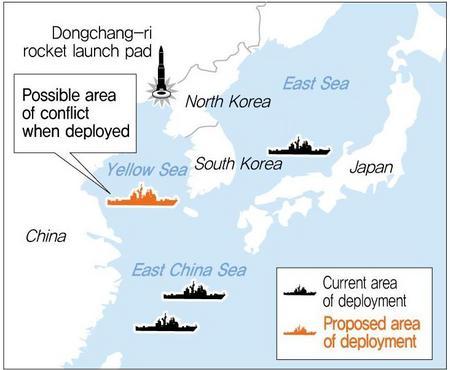Tokyo claims beefed up presence is due to North Korea’s rocket launch
Japan is considering dispatching Aegis destroyers from its Maritime Self-Defense Force (MSDF) to international waters west of the Korean Peninsula in the event of another rocket launch by North Korea. Though the MSDF claims the vessels would be sent to gather intelligence, some are concerned that sending destroyers equipped with a cutting edge maritime battle system onto China’s doorstep and near the two Koreas could cause backlash and further raise tensions in the West Sea area.
On Wednesday, Japan’s Asahi Shimbun newspaper reported information from a recently drafted report by an investigation team at Japan’s Ministry of Defense (JMD). The report identifies problems with Japan’s response to North Korea’s attempted launch of a long-range rocket in April. The report reads, “[JMD will] Consider dispatching destroyers to ‘waters in the vicinity of the launch site’ in order to more easily detect the course of the missile if North Korea gives advance warning of a missile (or rocket) launch.”
The Asahi Shimbun reported, “Although the report does not directly mention the West Sea as the place to which the destroyers would be dispatched, a Ministry of Defense official explained that the southwestern part of the West Sea was being considered, saying, ‘waters in the vicinity means the West Sea’.” The report, which was approved on Monday by defense minister Naoki Tanaka, is due to be officially announced after final discussions at the prime minister’s official residence.
These plans from the JMD are part of its response to public displeasure with Japan’s failure to rapidly detect North Korea’s long-range rocket launch. At the time, Japan had dispatched three destroyers equipped with SM3 interceptor missiles to the East Sea and the South China Sea. In spite of this, the JMD only announced that the rocket launched by the North at 7:39am on April 13 had crashed into the sea straight away at around 8:20am, while Korean media reported the fact 15 minutes after the event, quoting intelligence agencies.
Japan may be using this domestic criticism as a pretext to increase the Japanese navy’s area of activity. Although the vessels to be dispatched differ according to type, they generally possess strong information detection capabilities, with radar ranges of around 1,000 kilometers. If Aegis destroyers are dispatched to the West Sea, this would enable Japan to easily see missile training at military bases on China’s eastern coast and assess the training of China’s air force.
South Korea and the United States planned in July 2010 to send the USS George Washington into the West Sea as part of joint military exercises in response to the sinking of the Cheonan, China objected strongly and the exercises were relocated to the East Sea.
Last year, in order to monitor China’s maritime expansion, Japan amended a Defense White Paper to change the MSDF from a defensive to an offensive force. On April 30, at a summit meeting in Washington, US president Barack Obama and Japanese Prime Minister Yoshihiko Noda redefined the character of the US-Japan alliance as one that aimed to balance China‘s growing presence in the Asia-Pacific region.
The Chinese government has yet to issue an official response, but it is more than likely to object if Japan sends Aegis destroyers into the West Sea. “Japan’s Aegis destroyers have a very wide combat radius, so that China falls within it even when [the destroyers] are in international waters,” said Kim Jong-dae, editor of the online military journal Defense 21+. “Conflict may arise, because China’s official stance is that there are no international waters in the West Sea.”
The South Korean government’s stance is that there are no grounds to prevent Japan from sending its destroyers into the West Sea if they remain in international waters. An official from the Ministry of Foreign Affairs and Trade said, “We have not yet received notice of anything from Japan. We will try to determine whether or not this is true.”



0 comments:
Post a Comment